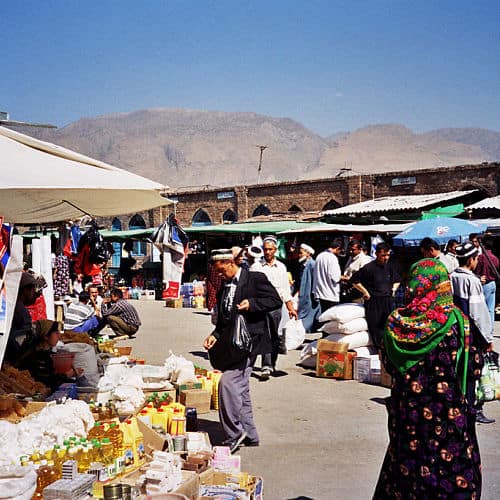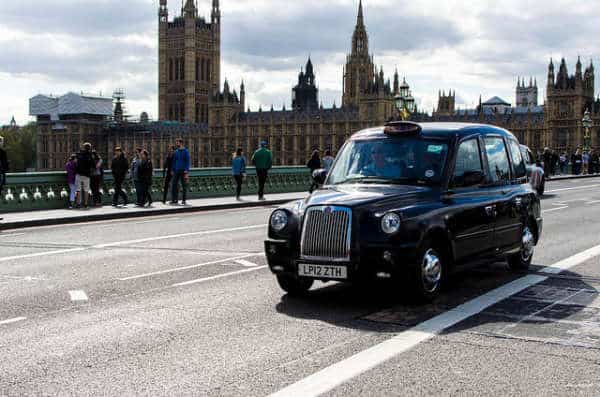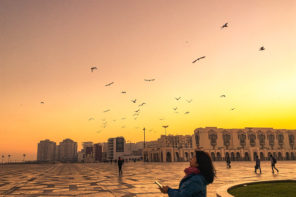This piece explores the activities of Afghan merchants in the former Soviet Union especially Tajikistan in Central Asia and Russia and Ukraine. It brings attention to the problems with categorising such actors either as economic migrants or refugees/exiles, and focuses instead on the combined significance of push and pull factors in shaping their patterns of mobility.
Over the past several years I have been conducting research with commodity traders of Afghan background. Between July 2012 and September 2013 I was able to pursue this research for a year long-period of intensive ethnographic fieldwork. As the security situation in Afghanistan itself wasn’t suited for long-term fieldwork, I focused my attention on the activities of Afghan traders in the contexts of the former Soviet Union, most especially in Tajikistan, a Muslim-majority republic of Central Asia, Russia, and the Ukraine. I also spent three months in China, a country to which many Afghan diasporic traders travel to commission and purchase commodities, ranging from bags and leather goods, to children’s toys and tourist souvenirs.
After the collapse of the Najibullah regime in 1992, Afghans who had worked and studied in the Soviet Union during the preceding decades quickly spotted the business opportunities available to them in the wake of the collapse of the command economy. The rise to power of a divided array of mujahidin groups in Kabul also made life in Afghanistan dangerous, especially for individuals and their families who were associated with the pro-Soviet regime. As a result, many officials from that era left Afghanistan and established themselves as commodity traders dealing in a wide range of good across the former Soviet Union. In Tajikistan for example Afghans dealt in the wholesale of Iranian and Pakistani foodstuffs and Turkish cosmetics. In the Ukraine and Russia, Afghans pioneered the import of low grade and cheap Chinese commodities, initially travelling to the city of Urumqi in China’s Xinjiang province and bringing the goods back in trucks to Moscow and Kiev.
Today, Afghan trading communities are to be found across the whole region in capital cities and economic centres such as Kiev, Moscow, St Petersburg, and Dushanbe, as well as in smaller commercial centres like the Black Sea port of Odessa, the southern Russian cities of Krasnodar, Rostov-on-Don, and Stavropol, and the historic Central Asian trade node, Khujand. During my most recent visit to Ukraine in April 2014 I even met traders who had moved their commercial operations from Odessa to the Crimean city of Simferopol, now under Russian administration.
Importantly, these communities are no longer made-up only of one-time Soviet era official-exiles. Communities of Afghan traders continue to be replenished by new migrants and merchants fleeing war in Afghanistan, and looking for locales in which to invest the capital they have earned over the past decade of foreign intervention. It is usual for example to encounter the recently-arrived cousins of Afghan residents who have been resident in Russia. Such individuals and their families say they have chosen to move out of Afghanistan in recent years because of growing levels of insecurity. Additionally, I have met several men in Russia and Ukraine who earned money working alongside ISAF forces in Afghanistan and then left the country with a portion of the money they had earned with the hope of establishing a profitable trading venture. Not all recent Afghan migrants in the former Soviet Union come directly from Afghanistan. I have also met Afghans who now work in settings across the former Soviet Union who have travelled there from the Americas and Europe, including Canada, Holland, and the United Kingdom. They say that the former Soviet Union furnishes the possibility of earning a living through trade, and also of passing a well-lived life.
It is tempting to think of such merchants as being war profiteers, or, alternatively, of trade as being a form of economic activity that acts as a survival strategy for refugees and migrants at times of economic and political insecurity. Yet I have been struck during my fieldwork by the extent to which my informants attach positive moral value to their way of earning a living. On the one hand, as is the case of traders in other settings in South and Central Asia, they do often complain that they find being ‘traders in a foreign land’ a source of shame and embarrassment, and that the only reason they make a living in such a way is because of the plight their families face in Afghanistan.
On the other hand, however, I am often told that trading is a ‘free’ and therefore honourable way of earning money, and the settings of the former Soviet Union are a good place to live because their proffer the chance of ‘free work’: ‘the best work an Afghan like me can do in London’, said Seyyid, a trader in Pakistani tangerines in Khujand, Tajikistan, ‘is to be a taxi driver: here in the former Soviet Union with $20,000 a man can set up some trade in one thing or another and live a free life’.
The traders, like those across space and time, live far more complex and precarious lives than such representations suggest. For one thing, Afghans in Central Asia, as is the case with historic trading communities in Southeast Asia and Central Europe, are often vilified by local populations and political elites alike for being low status market workers who ‘love money but have no idea how to live life’: Afghans in Tajikistan, for instance, routinely complain that the country’s police force target them for bribes, and even frame their compatriots on drug smuggling charges.
Afghan traders across the settings to which I have travelled also say that their work is being harmed both by the growing influence of multi-national companies and of national monopolies, cartels and mafias. Afghans in Tajikistan, for instance, were once major actors in the export of asafoetida from the country – today this lucrative trade has been placed in the hands of state monopoly. Such difficulties are leading many of my informants to question how far they will be able to continue to earn an independent living as commodity trades: some are moving their activities to settings they perceive as being ‘good for trade’, such as Odessa in the Ukraine, or the city of Yiwu in eastern China; others are seeking to acquire refugee status in Europe. In 2014, the year the foreign military intervention in Afghanistan officials draws to an end, few, however, talk of return to Afghanistan as being either a safe or economically viable option.
During the years over which I have conducted research on Afghan trading networks, both the traders themselves and the communities amongst whom they live have experienced ongoing political and economic upheaval. My initial fieldwork in Central Asia between 2006 and 2010 took place at a period of time during which many Tajikistan-based Afghans were optimistic about the future prospects for Afghanistan; indeed, Tajikistan-based Afghan traders often spoke about Afghanistan as a base to raise capital, frequently travelling to the country for example both to visit their families and to gather funds earned through renting their properties. This contrasted markedly with my experiences during three months of fieldwork in Tajikistan between October 2013 and January 2014: during those months traders discussed amongst themselves the uncertainty of Afghanistan’s future of the country in 2014 (the year in which ISAF forces would official cease combat mission in the country).
Many also expressed to me a sense of ‘hopelessness’ about the fate both of Afghanistan, and of their individual life prospects.
The changing conditions in Afghanistan had important implications for the activities of traders in Tajikistan: a rise in the number of Afghan migrants in Tajikistan led to greater competition in the trading activities in which Afghans were involved. Furthermore, Afghanistan’s worsening economy meant that men who had previously frequently used their home country as a base to raise capital complained that falling prices alongside insecurity no longer made the making of such journeys either feasible or worthwhile.
Shifts in Afghanistan’s political and economic dynamics are not the only type of event over the past eight years that has affected the lives of the traders. The financial crisis of 2007-08 had significant ramifications for many if not all of the traders introduced across its pages: Afghans in Ukraine who were involved in the import of container loads of Chinese goods to the country’s Black Sea ports remember 2007 as the year after which their sales declined irrevocably. Likewise, several of the shopkeepers I came to know in London found it impossible to maintain their own businesses in the years following 2007, and thus turned to other forms of work instead, especially taxi driving. The tightening of sanctions in 2010 on Iran’s financial institutions also had varying implications for Afghan traders based in Central Asia: creating opportunities for some and raising the costs of trade for others. Even more recently, the ongoing political unrest and upheaval in Ukraine (anti-government protests started in Kiev in November 2013) and the concurrent decline in the value of the Hryvnia has placed even greater pressures on Afghan importers of Chinese goods. Yet some Afghans in Ukraine have sought to benefit from opening trading opportunities in this period of flux, embarking on ‘marketing tours’ to the Crimea (annexed by Russia in February 2014) in anticipation of growing levels of investment in the region by the Russian state.
There are a range of issues – both ethical and analytic – that inevitably come with blurring the boundary between refugee and trader in the manner that I am suggesting here. Analytically, however, doing so is more faithful to my informants’ self-understandings. It also better represents the range of forces important in understanding their mobile life trajectories. The most sophisticated of recent work on trading networks is critical of Philip Curtin’s (1983) suggestion that the origins of such circulation societies lies in migration for primarily commercial motives. Many trading networks, rather, are based on mobility caused by a combination of economic and both political “push” and “pull” factors. In his study of historic Armenian merchant networks Aslanian (2014) holds for example that in the case of that network it is impossible to disentangle commercial motives for mobility from the experience of being uprooted or displaced. Aslanian’s analysis of Armenian networks is helpful in thinking about Afghans in the former Soviet Union. There is no doubt that their presence in this region reflects the legacy of imperial power struggles between the Russian and British Empires, of Soviet policy, and also of the Cold War’s afterlife (Kwon 2010). But at the same time commercial motives are an important element of the explanations that these men themselves give for having travelled to the shurawi-i sabiq.
As a young man aged about eighteen told me and some other Afghans in the 7-km wholesale market in Odessa, ‘we came to Ukraine not to sit around in a refugee hostel and wait for a document but to make some money and becoming something’.
Categories such as “economic migrant” and “refugee” are far too simplistic for understanding the shifting experiences and motivations of the actors who make up circulation societies or trading networks such as that I have described here. Rather than assuming that the blurring of boundaries between such analytical categories is likely to further risk the lives and livelihoods of refugees and migrants, better recognition of problematic ways in which they are used in popular discourse is ultimately more likely to refine attitudes and policy than well-intended acts of “ethnographic refusal”.
References:
Aslanian, Sebouh David, From the Indian Ocean to the Mediterranean: The Global Trade Networks of Armenian Merchants from New Julfa, Berkeley, University of California Press, 2014.
Curtin, Philip, Cross Cultural Trade in World History, Cambridge: Cambridge University Press, 1984.
Kwon, Heonik, The Other Cold War, Columbia: Columbia University Press, 2010.













